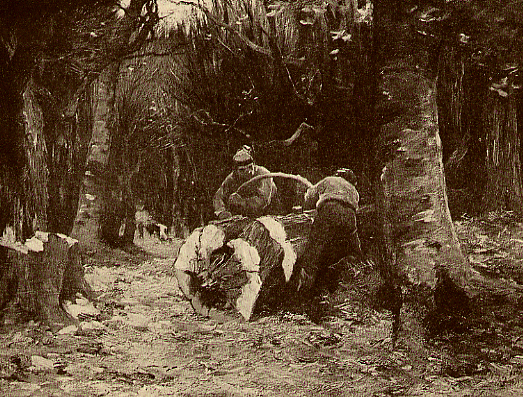Canadian Feudalism...

A depiction of men felling trees by Horatio Walker.
Notes on the subject of Canadian Feudalism taken from a book written by George M. Wrong entitled "The Rise and Fall of New France" published by The MacMillan Company, New York, 1928, Volume I.
The Company of New France had granted some sixty seigneuries, chiefly to directors and their associates, most of whom never saw their holdings. The grants had been recklessly made and without a proper survey, but even so it was not easy to cancel them. The extensive grants caused the great evil that settlers were widely scattered and this meant greater peril from the Iroquois. In 1663, Louis XIV ordered the owners to clear their lands within six months, on pain of forfeiture of the uncleared portions. The tough primeval forest was, however, not to be so easily tamed and when Talon arrived in 1665 the order remained a dead letter. (taken from page 397)
In mediaeval France feudalism had developed to meet the needs of a society not yet stable. The central power was weak and the sovereign conceded lands to great landowners on condition that they should maintain order on their own property and come to their rescue in time of need. While the system had been useful in the old world, it had now served its day. (taken from page 400)
During the first year or two on the land the habitant would live in a primitive hut of wood, divided perhaps into two small rooms, a bedroom and a kitchen. Nature furnished a bountiful supply of building material in the logs cleared from the land. The soil, enriched through centuries by the decay of fallen leaves, was fertile. Barns were quickly built. (taken from page 409)
Life on the seigneuries became quickly patriarchal. Early marriage brought children and even grandchildren, while the ancestor was still in the prime of life. Often two families lived in one house under the rule of the head of the family and there was a closely-knit family life. The sense of deference to its head was strong; even scattered members still looked upon the parental house as home; and there was a tradition that those who needed a refuge might always return and there find it. When a son set up for himself, either a new grant was sought from the seigneur, or a long strip fronting on the river was taken from the father’s perhaps generous acres of land.
The Canadian village had its share of human frailty. The long winter suspended work on the land and encouraged habits of idleness. The habitant was often a careless farmer, more expert with his axe in cutting down the forest than with the plough in making use of the soil when cleared. With his Norse blood he loved an adventurous life, and far too many settlers went off to the interior as voyageurs, to paddle the great canoes of the fur-traders, and to live the free and careless life of the hunter and the trapper. They might bring back to the villages a little money, often quickly spent in drink, and some of them certainly brought shiftless habits. (taken from page 415)
